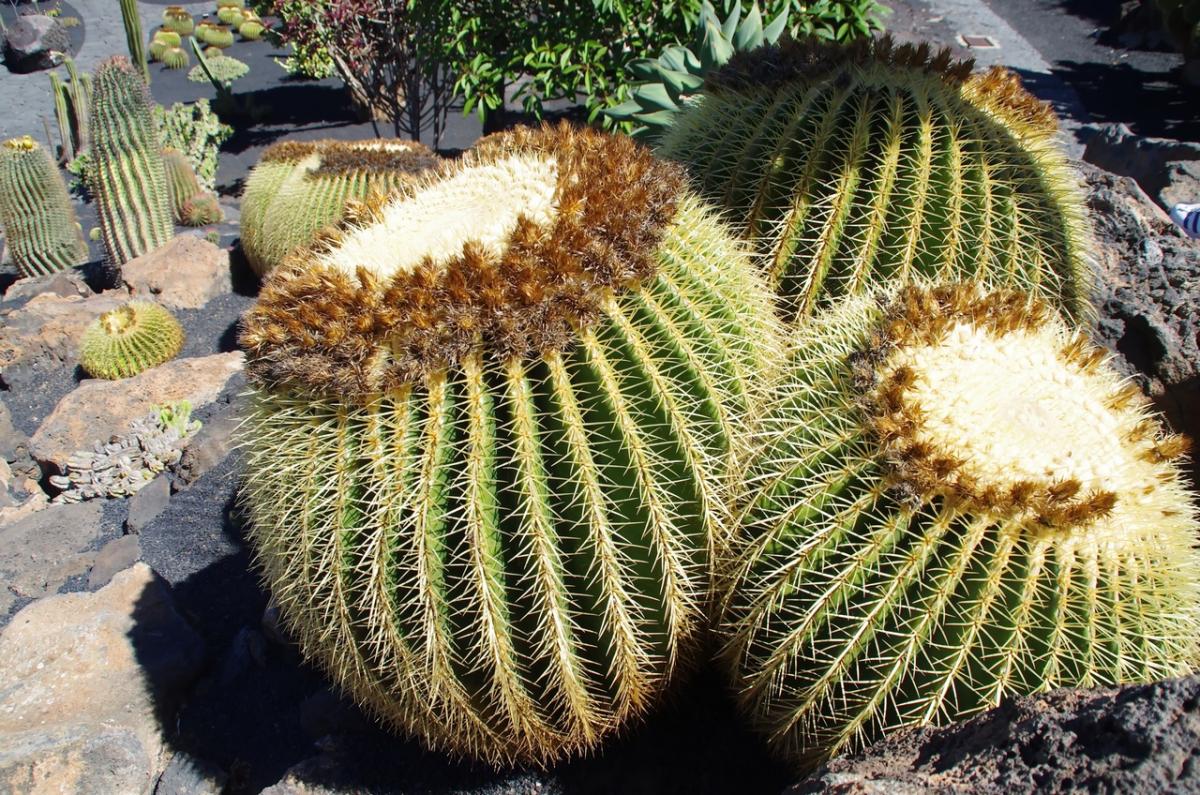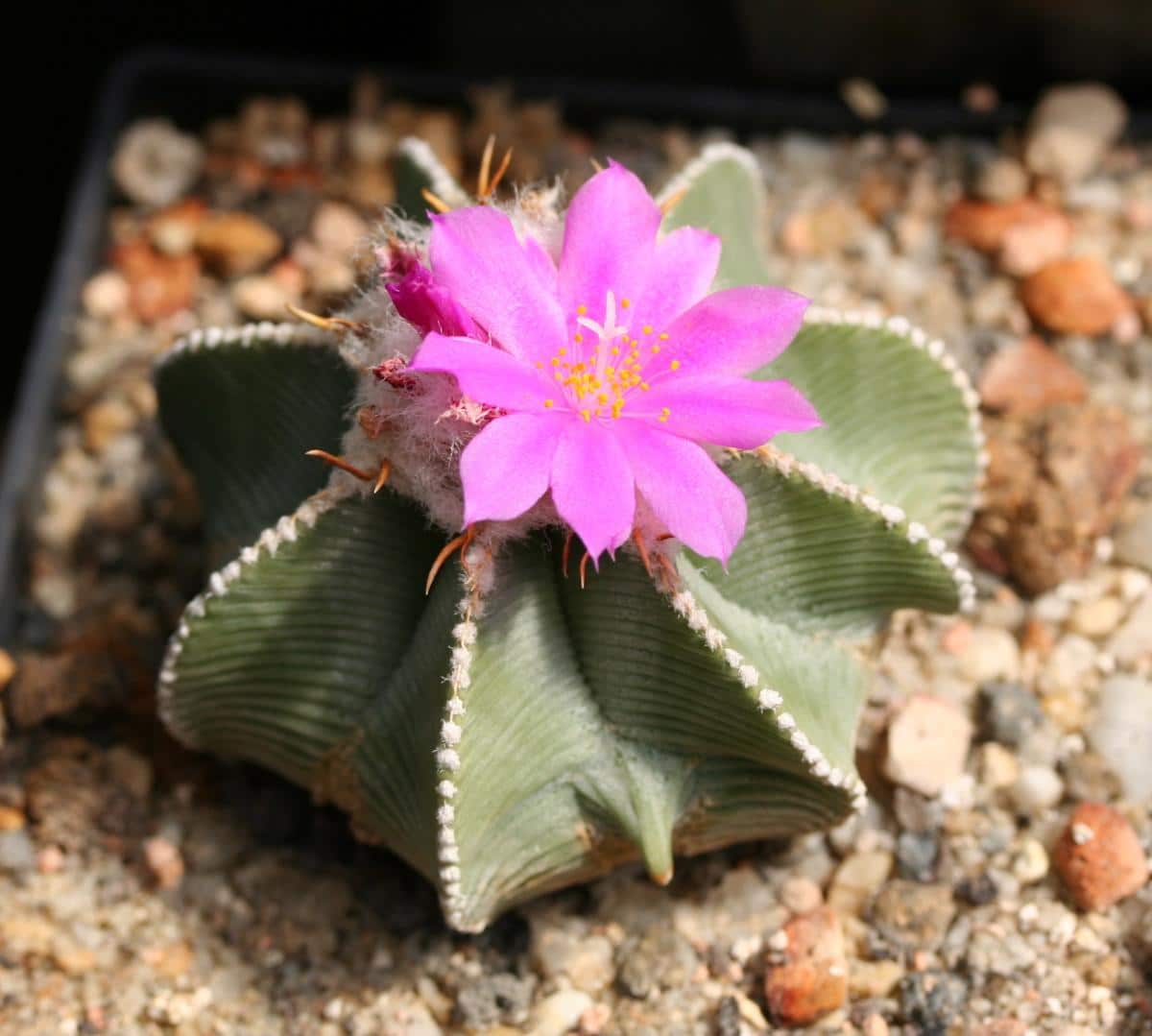
Echinocactus grusonii
Cacti can be of different shapes, but basically the most common are two: columnar and globular. The first are those that develop vertical stems, more or less thin, and with a very variable height, which can exceed ten meters; the others, on the other hand, have a rounded shape, and rarely exceed one meter in height. For this reason, the latter are often preferred to be grown in pots, although there are certain species that grow better in the ground.
If you want to know what are some names of globular cacti, those that produce very beautiful flowers or that have another natural charm, then you will be able to meet them.
Aztekium hintonii

Image - Wikimedia / Michael Wolf
El Aztekium hintonii, known as stone biznaga, is a very special cactus. It is not always for sale, and when it is, its price is usually high. The reason is that it grows very slowly. In addition, its cultivation is not as simple as that of others, since it requires a substrate that drains water quickly, such as the cheekbone.
The plant has a flattened, globular stem. Measures 5-7 centimeters in diameter by only 3-5 centimeters in height, and presents 9-11 ribs with areoles, from which 1-3 spines of up to 4 millimeters in each sprout. Its flowers are small, 2 cm, and pink.
Ferocactus viridescens

El Ferocactus viridescens it is one of the few species of the genus Ferocactus that maintains its globular shape and low height always. Measures up to 30 centimeters in height by roughly the same diameter, and it is dark green. It is a thorny plant, with 4-9 central and 8-25 radial spines. All of them are gray when they finish maturing, but they are reddish in their youth.
Its flowers are medium-sized, 5 centimeters high by 6 centimeters in diameter, and yellowish-green in color. Thanks to the fact that it does not grow much, it is very interesting for large clay pots (35 centimeters in diameter or 40cm), placed for example in the patio.
Echinopsis subdenudata

Image - Wikimedia / Petar43
El Echinopsis subdenudata it is a solitary cactus whose body has 8 to 12 ribs with white areolas. From these, 3-7 radial and 1 central spines sprout, but they are so small that they can hardly be seen (they measure about 2 millimeters). It is a dark green plant, which measures about 7 centimeters tall by 4-5 centimeters in diameter, and that produces tubular flowers up to 22 centimeters long.
It is a very floriferous plant, so even though its flowers only last one day, you won't have to worry as it can produce several in a season.
Lophophora williamsii

Image - Wikimedia / Dornenwolf
La Lophophora williamsii It is a cactus known as peyote. Its body is more or less spherical, and very compact. It can measure 2-12 centimeters in diameter by 5 centimeters in height, and is grayish-green to bluish-green in color. Only spines (and very short) sprout from their areolas during their youth.
It blooms producing pink flowers 1-1,5 centimeters in diameter. It is a plant with a high ornamental value, but it is important to know that its growth rate is very slow, taking 30 years to reach its final size.
Mammillaria theresae

Image - Wikimedia / Michael Wolf
La Mammillaria theresae, known as coneto biznaga, is a solitary cactus, although it tends to branch, with a globose gel genus Mammillaria. Its height is 2 to 4 centimeters, and its diameter is 1 to 2,5 centimeters. It is so small that we recommend growing it in a pot, and not so much in the ground. In addition, it has thorns but they are feathery, totally harmless.
Its flowers are funnel-shaped, 3-4 centimeters long, and are white, purple, or violet in color. A real gem for the collection.
Matucana madisonorum

Image - Wikimedia / Petar43
La Matucana madisonorum it is a small and solitary globular cactus, with a height of 15 centimeters and a diameter of 10 centimeters. Its body is greenish-gray in color, and up to five dark brown spines about 3 centimeters long sprout from its areoles that are slightly curved and flexible.
The flowers are funnel-shaped, 8 to 10 centimeters long by 4-6 centimeters in diameter, and a beautiful orange-red color. For all these reasons, it is an ideal species to grow in pots.
Rebutia fiebrigii

Image - Wikimedia / Peter A. Mansfeld
La Rebutia fiebrigii (before Rebutia albipilosa) is a cactus of the genus Rebutia that can grow alone or in groups. Its body is spherical, green, and measures up to 6 centimeters tall. White or light brown spines sprout from their areoles, sharp and up to 2 centimeters long.
Its flowers are about 3,5 centimeters, of a beautiful yellow or orange color. As a curiosity, you should know that they do not sprout at the top of the stem, if not in the middle of it.
Which of these globular cacti did you like the most? Do you have any? There are many others, like the Echinocactus grusonii known as the mother-in-law's seat that you could see in the image above, or the Ferocactus glaucescens, but we wanted to select only those that can be grown both in pots and in the garden so that you can choose where to grow them.
We hope they have been to your liking.